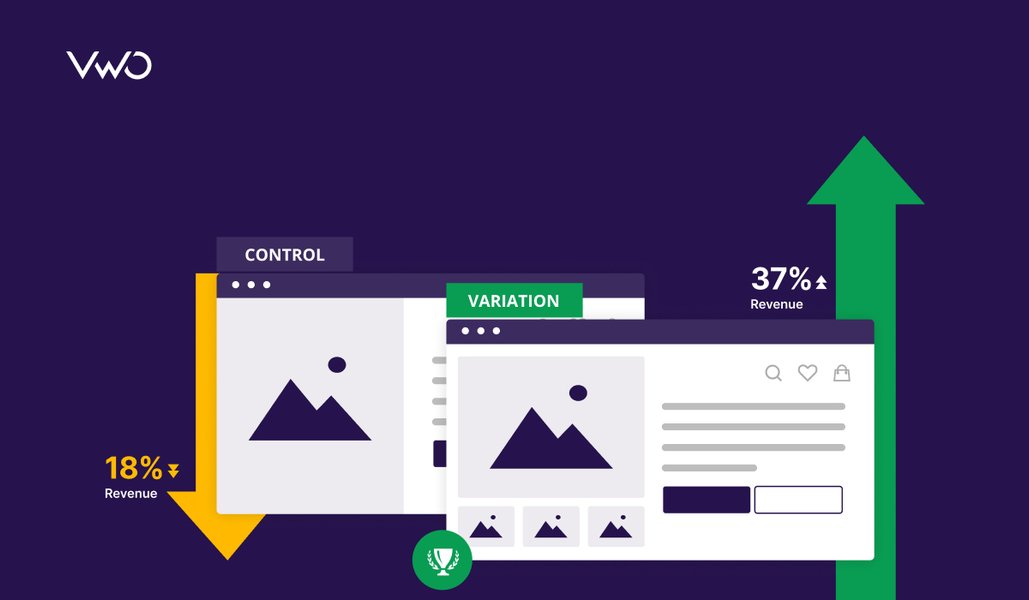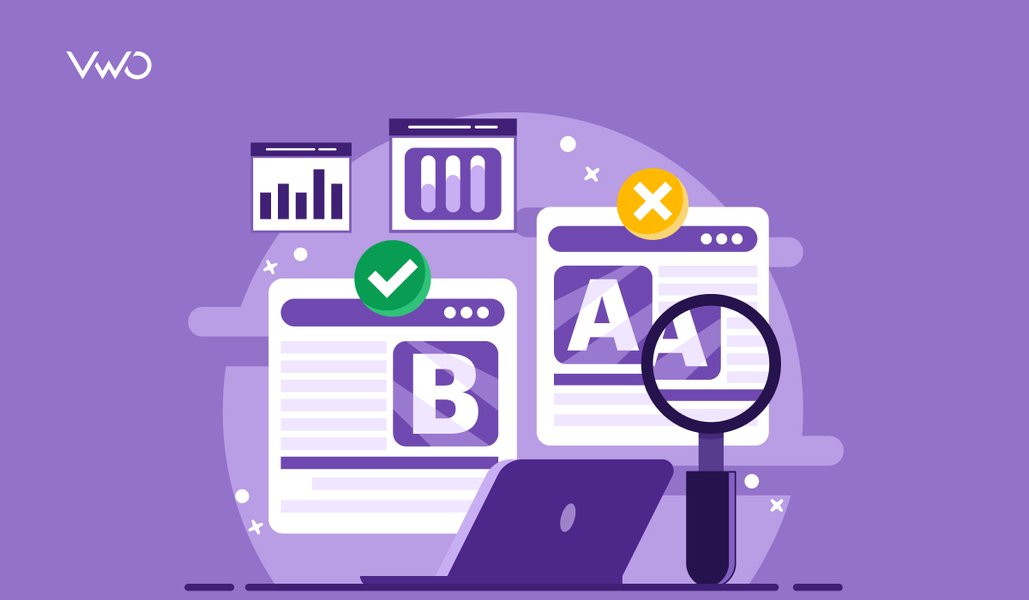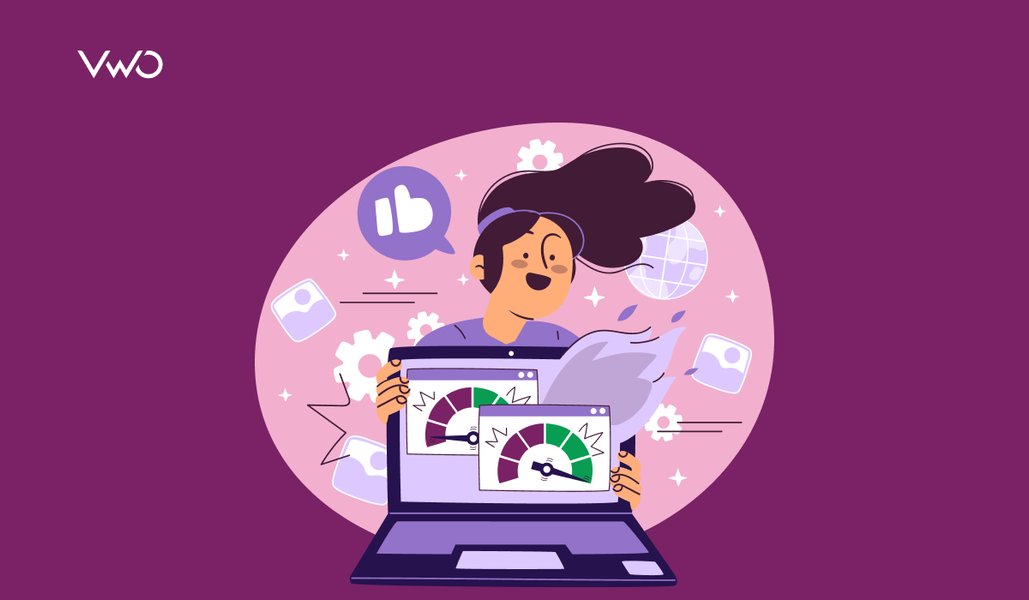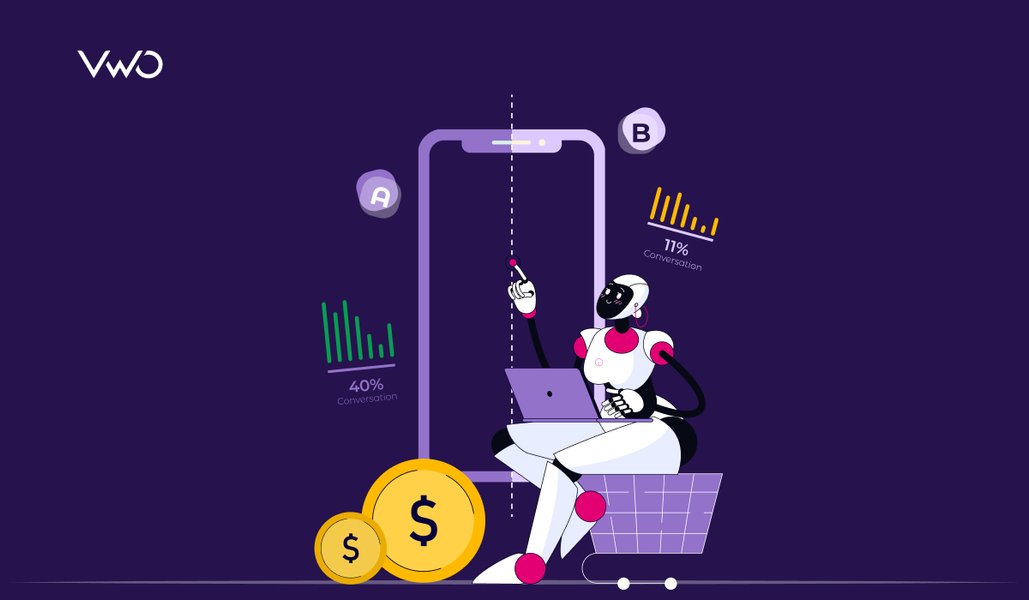According to the 2024 Marketing Technology Landscape report, the number of tools in the optimization, personalization, and testing segment jumped from 230 to 271 in just one year.
With so many options out there, it’s easy to feel overwhelmed by the paradox of choice. In this blog, we’ve streamlined the process by narrowing down the top 15 best A/B testing tools, ranked by CRO experts from hundreds of options.
We’ll give you an overview of each tool, walk through key business requirements while taking a look at which tools meet those needs. On top of this, the blog also contains insights from A/B testing experts on choosing the right tool based on their experience.
We will also compare important features, pricing, and real user reviews of the listed tools so that you can make the right decision. This guide aims to help you find the best A/B testing platform for your business.
What are A/B testing tools?
A/B testing tools are software applications that let businesses test two different versions of a webpage, app screen, or feature to find out which one works better.
They split users into groups at random: one sees the current version (A) and the other sees a modified version (B). The tool then measures which version leads to more clicks, sign-ups, or other goals.
This helps teams make informed decisions and improve the user experience using real data instead of assumptions.
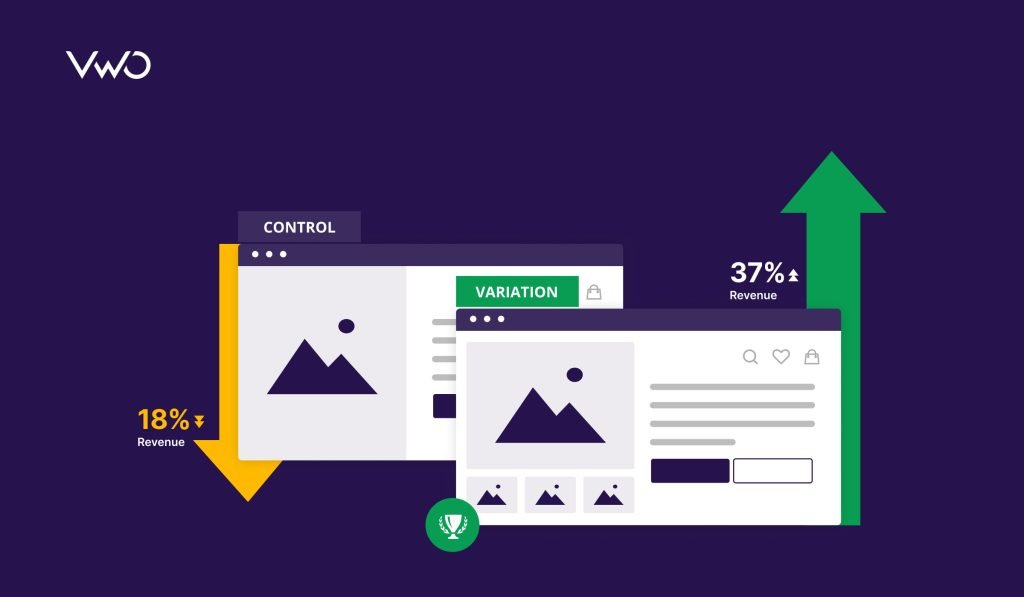
A/B testing tools – A quick look
- VWO
- Optimizely
- AB Tasty
- Adobe Target
- Dynamic Yield
- Kameleoon
- Convert
- Omniconvert
- LaunchDarkly
- Statsig
- Unbounce
- ABsmartly
- Sitespect
- Apptimize
- Split.io
15 best A/B testing tools in 2025
Let’s help you make an informed choice. Here we have a curated list of the top 15 A/B testing tools available on the market along with key details related to each tool.
A/B testing tools: A quick comparison table
Here’s a quick comparison of the tools, highlighting their key capabilities and starting prices for paid plans.
| Sr no. | Tool name | Noteworthy capabilities | Is a forever-free plan available? | Starting paid plan |
| 1 | VWO | ‣ Behavior targeting ‣ Multi-armed bandit ‣ Generative AI for A/B test automation ‣ Personalized image generation | Yes | From $154/month |
| 2 | Optimizely | ‣ CDP integration ‣ Advanced omnichannel personalization ‣ Bayesian and Frequentist stats engine | No | On request |
| 3 | AB Tasty | ‣ Multi-armed bandit testing ‣ Audience and behavior-based targeting ‣ AI for visitor segmentation based on emotional states | No | On request |
| 4 | Adobe Target | ‣ Multi-touch campaigns ‣ AI-driven personalized offers ‣ Behavior targeting | No | On request |
| 5 | Dynamic Yield | ‣ Predictive targeting ‣ AdaptML deep learning for next-best product predictions | No | On request |
| 6 | Kameleoon | ‣ AI-driven segmentation and personalization ‣ 45+ native targeting criteria | No | On request |
| 7 | Convert | ‣ Flicker-free client-side testing ‣ Customizable targeting ‣ AI-based text suggestions | No | Starting at $199/month |
| 8 | Omniconvert | ‣ User segmentation ‣ Bayesian and Frequentist stats engine | No | From $273/month |
| 9 | LaunchDarkly | ‣ Feature flagging ‣ Funnel experiments ‣ Full-stack optimization | Yes | From $12/month |
| 10 | Statsig | ‣ Bayesian and Frequentist stats ‣ Multi-armed bandit testing ‣ Heterogeneous effect detection | Yes | From $150/month |
| 11 | Unbounce | ‣ AI-based copywriting ‣ Landing page builder with A/B testing | No | Starting at $74/month |
| 12 | ABsmartly | ‣ Group sequential testing ‣ Robot and scraper detection ‣ Conflicting experiments detection | No | €60K/year |
| 13 | SiteSpect | ‣ No flicker effect ‣ Mobile targeting ‣ Comprehensive API | No | On request |
| 14 | Apptimize | ‣ Cross-platform testing with patented technology ‣ Audience segmentation | Yes | On request |
| 15 | Split.io | ‣ Feature flag management ‣ SDKs for multiple platforms ‣ Instant feature impact detection | Yes | $35/month |
1. VWO
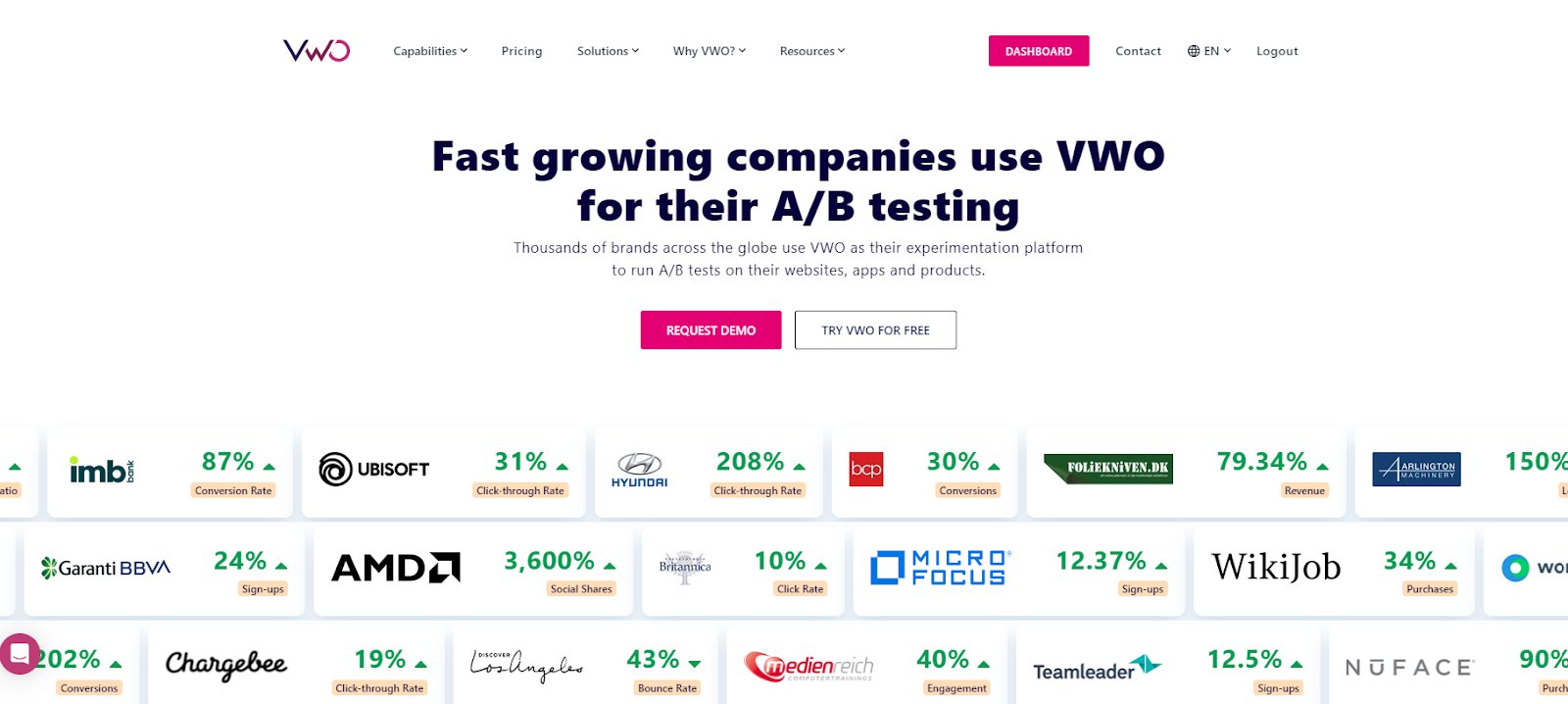
VWO started its journey in 2010 with a simple drag-and-drop editor. Since then, it has evolved into an end-to-end experience optimization platform.
Today, VWO offers a suite of integrated tools. These tools help unify customer data, uncover behavioral insights, and run A/B tests across web, mobile, and server environments. With VWO, you can also roll out new features, personalize customer experiences, and optimize the entire customer journey.
Test types: A/B Testing, Split URL Testing, Multivariate Testing
Statistical model: VWO’s Bayesian-powered SmartStats engine accounts for common biases like sequential testing errors and Bonferroni errors so you can focus on getting reliable and real-time reports.
You can visit the VWO Stats Blog to learn all about complex statistical concepts and learn about VWO’s statistical research in A/B testing.
Noteworthy features: Audience and behavior targeting, mutually exclusive campaigns, code editor, test triggers, in-app comment feature for cross-team communication, multi-armed bandit testing, ease of expansion to project management and behavior analysis capabilities, and data integration with over 40 platforms, including Google Analytics, WordPress, Shopify, and more. Also, it has editable statistical parameters, constant experiment health checks, and guardrail metrics.
AI-based features: VWO leverages a generative AI engine that allows users to generate tailored optimization ideas simply by entering a webpage URL.
Supported testing platforms: Web, Mobile apps, Server-side
Pricing: It is based on monthly tracked users (MTU) and the chosen platform.

For more detailed pricing and plan information, visit VWO’s pricing and plans.
| Pros | Cons |
| No flickering is ensured for client-side testing with a single-line asynchronous smart code. Plus, SDK-based server-side tests mean no latency and allow users to conduct omnichannel. | Less advanced feature management as it is not the core offering of the platform. |
Customer experience:
Here is what Jared Brown, CEO of Hubstaff, shared about using VWO
VWO had clear and concise documentation, and we didn’t have to go through sales calls to get on and running.
Also, it had transparent pricing, and we could know how much we would need to pay once we confirmed that VWO suits our needs. They even had a trial so we could test the product and see if it fit our needs.
We only used the redirect A/B tests, and the variant had the same URL as the control with a custom AB parameter. To track the A/B test result, we were using targeted page views and triggering VWO custom goals. Besides this, we were also checking the results via our internal analytics tool because VWO allowed us enough flexibility to use the product according to our needs.
– Jared Brown,
CEO of HubStaff
2. Optimizely
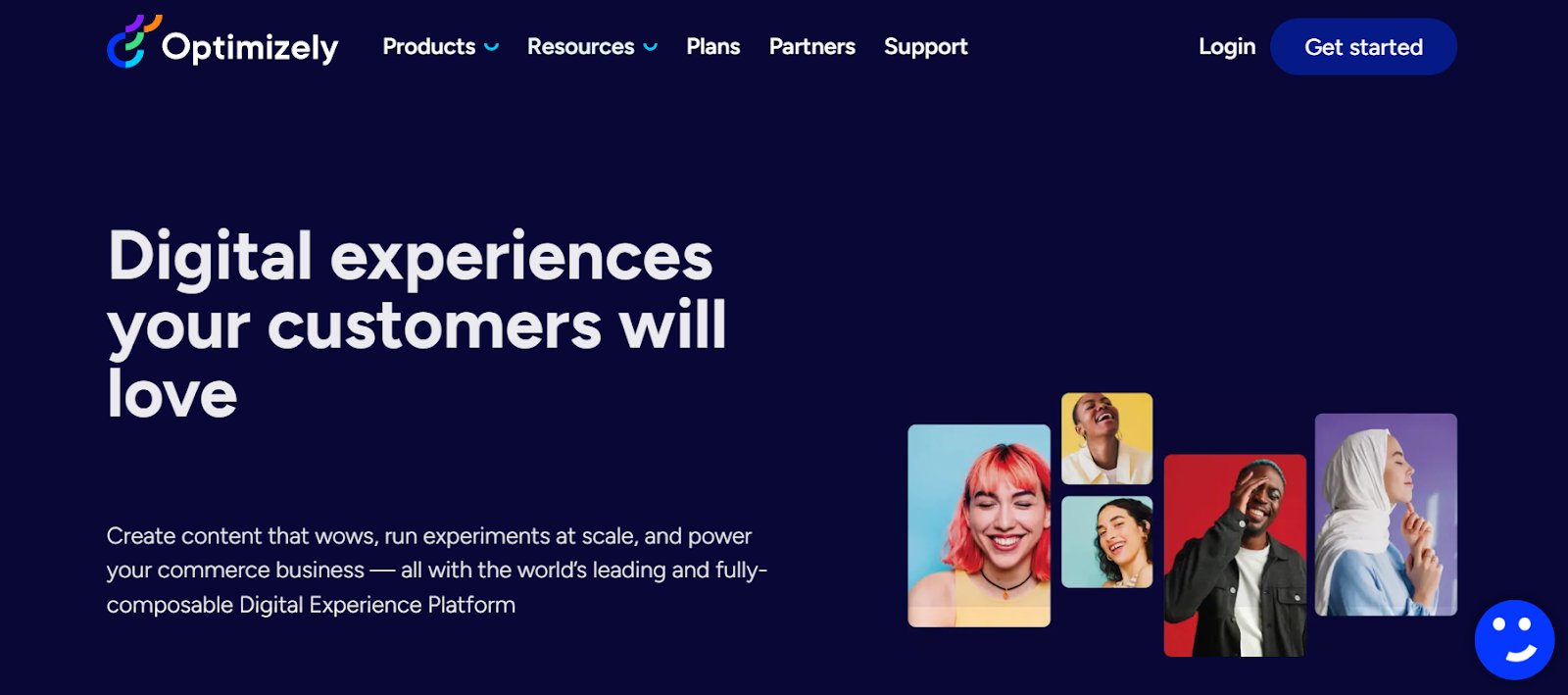
Optimizely is a comprehensive digital experience platform that provides web and feature experimentation capabilities, content management, and advanced personalization engines. Its project management capabilities are available on both client and server-side testing. Additionally, Optimizely integrates a Customer Data Platform (CDP) to centralize and harmonize customer data.
Test types: A/B Testing, Split URL Testing, Multivariate Testing
Statistical model: The statistics engine leverages the Bayesian and Frequentist statistics model.
Noteworthy features: WYSIWYG editor, CDN A/B testing, multi-armed bandit testing, audience targeting, mutually exclusive campaigns, advanced omnichannel personalization solutions, and advanced native integration for server-side testing.
AI-based features: It has a generative AI-based text variation generator.
Supported testing platforms: Web, Mobile apps, Server-side, OTT
Pricing: It is available on request.
| Pros | Cons |
| It has Sequential Hypothesis testing that improves the accuracy of test performance and offers strong segmentation capabilities. | Switching between snippets and mini-snippets causes performance issues and delays the website loading time. |
A customer experience as per G2 reviews:
“The ability to control the percentage of a feature under experiment is one of the best tools I’ve used. Being able to turn on/off these experiments near instantly has helped reduce our mean time to resolve by at least 60%.” – Caleb Ruzicka, Quality Assurance Engineer II at uShip
3. AB Tasty

AB Tasty is an experience optimization platform that allows brands to deliver customer experience through experimentation and personalization. It is one of the leading tools in the market with a global market presence.
Test types: A/B Testing, Split URL Testing, Multivariate Testing
Statistical model: The stats engine uses the Bayesian statistics model.
Noteworthy features: WYSIWYG editor, comprehensive widget options, multi-armed bandit testing, audience, and behavior-based targeting.
AI-based features: AB Tasty enables users to leverage generative AI for visitor segmentation based on emotional states.
Supported testing platforms: Web, Mobile apps, Server-side
Pricing: It is available on request.
| Pros | Cons |
| Easy-to-use drag-and-drop editor to make changes to your web pages without involving your development team. | Implementation documentation doesn’t help a lot in solving user queries. |
A customer experience as per G2 reviews:
“Setting up tests is super easy! Implementation/integration for us was a little tricky, and we ran into some troubles with the reporting but we were helped along the way in all possible ways until it was solved.” – Linda Aarts, CRO specialist at Sitly
4. Adobe Target
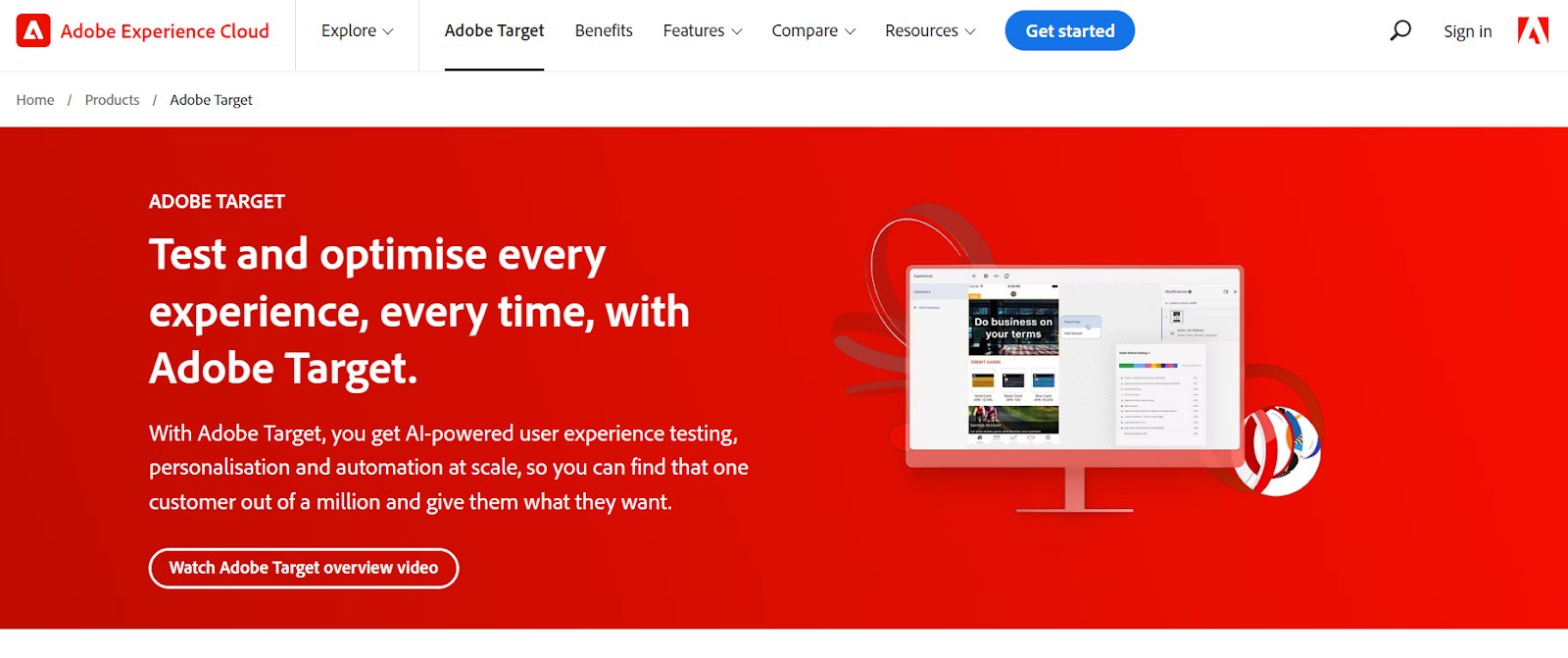
From the tech giant Adobe, Adobe Target is a comprehensive solution within the Adobe Experience Cloud. It offers a robust suite of features, including experimentation, personalization, and product recommendations, designed to optimize user experiences. Adobe Target also integrates seamlessly with other Adobe solutions, such as Adobe Analytics. As an enterprise-grade platform, it is often used by matured experimentation teams.
Test types: A/B Testing, Split URL Testing, Multivariate Testing
Statistical model: Adobe Target stat engine is based on a Frequentist statistics model.
Noteworthy features: WYSIWYG editor, advanced targeting based on behavior and attributes, and seamless integration with Adobe Experience Cloud tools.
AI-based features: It automatically allocates visitors to the winning variation earlier in the A/B testing process. Additionally, it offers features such as click-based personalized website experiences, AI-driven offer delivery, and intelligent product recommendations.
Supported testing platforms: Web, Mobile apps, Server-side
Pricing: It is available on request.
| Pros | Cons |
| Easy integration with Adobe Analytics helps with advanced audience segments and reporting. | Server-side SDKs do not support third-party integrations. |
A customer experience as per G2 reviews:
“The integration with Adobe Analytics provides powerful insights that help optimize campaigns in real-time. The ease of setting up experiments without needing deep technical expertise is also a big plus.” – Art Bukowski, Conversion Optimization Manager at K-rauta.se
5. Dynamic Yield
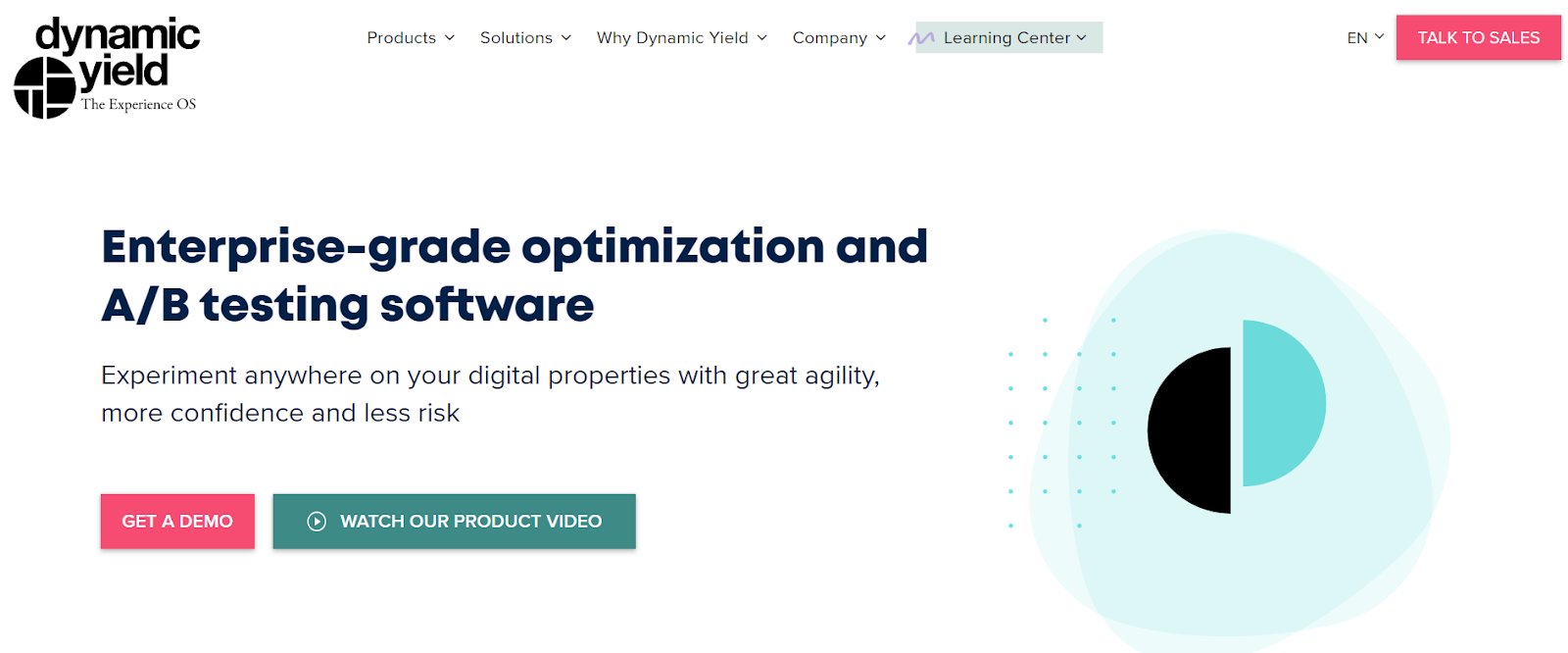
Dynamic Yield is an experience optimization solution from Mastercard. It is an advanced omnichannel personalization platform and offers testing features as a part of its ‘Optimize’ solution. The platform leverages its “Predictive Targeting” engine to extend personalization to highly specific audience segments, helping to synchronize and enhance user experiences across various touchpoints.
Test types: A/B Testing, Split URL Testing, Multivariate Testing
Statistical model: Dynamic Yield uses the Bayesian statistics model.
Noteworthy features: Multi-touch campaigns, multi-armed bandit testing, and seamless workflow for personalization.
AI-based features: It has AI-based text suggestions, audience segmentation capabilities, and personalization features, for example, AdaptML, a self-training deep learning system, enhances digital experiences by predicting customers’ next-best products.
Supported testing platforms: Web, Mobile apps, Server-side
Pricing: It is available on request.
| Pros | Cons |
| Run server-side tests with zero latency across your tech stack. | The absence of behavioral analytics tools limits the ability to analyze user behavior on websites. |
A customer experience as per G2 reviews:
“Its robust segmentation and targeting tools enable us to deliver impactful, data-driven campaigns across web, mobile, and email, creating a seamless omnichannel experience.” – Faith Okwuosa, Senior Product Manager at Chalhoub Group
6. Kameleoon
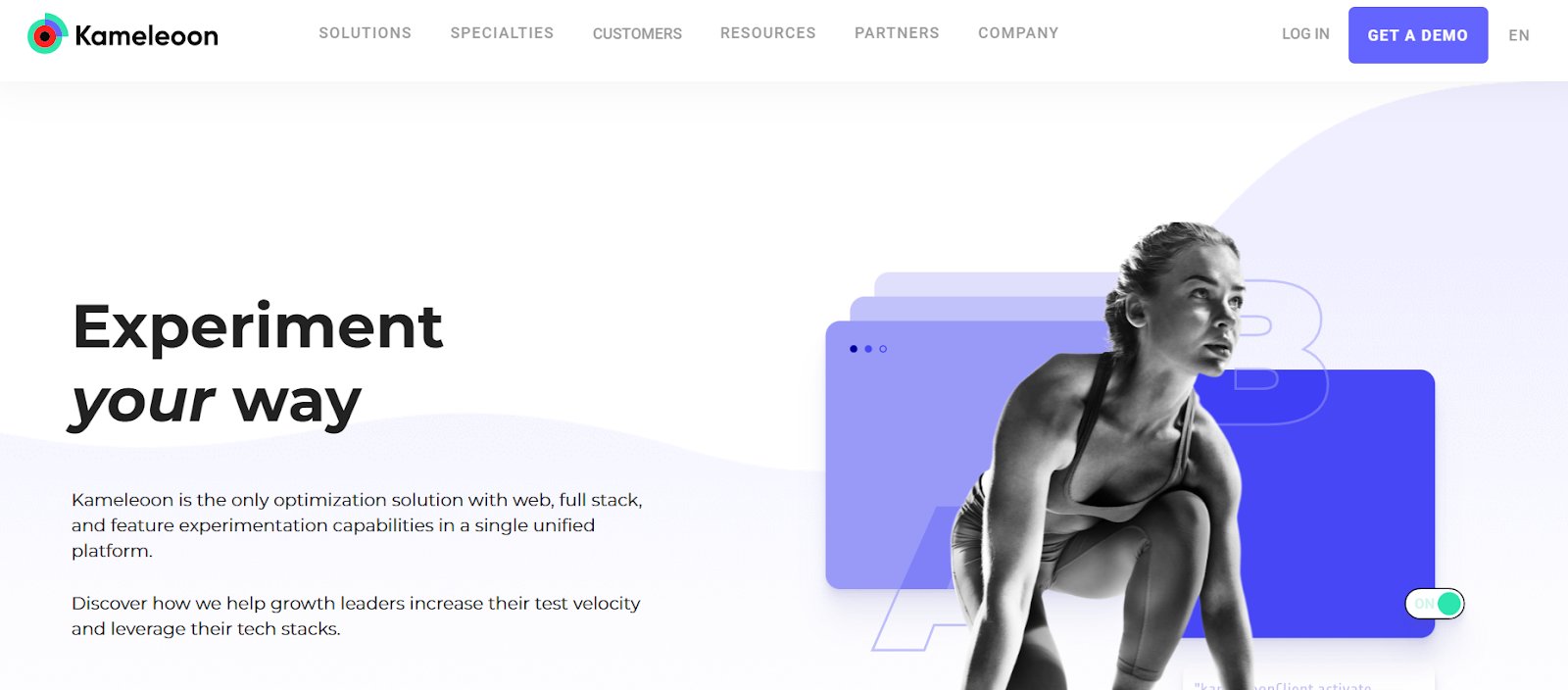
Kameleoon is a platform offering personalization, feature management, and website optimization. It empowers both product and marketing teams to accelerate their experimentation efforts while seamlessly integrating with their existing tech stacks.
Test types: A/B Testing, Split URL Testing, Multivariate Testing
Statistical model: Kameleoon by default, the experiment results are presented according to a Frequentist data analysis. But it also offers an option to switch to the Bayesian statistical model.
Noteworthy features: Widgets library, multi-armed bandit testing, 45+ native targeting criteria, 30+ integrations with 3rd party analytics, CRM, CMS, and more.
AI-based features: Kameleoon offers AI-driven capabilities that allow users to precisely target audience segments, create tailored version, and analyze test results to uncover optimization opportunities.
Supported testing platforms: Web, Mobile apps, Server-side
Pricing: Pricing is available on request.
| Pros | Cons |
| Strong custom-based targeting capabilities are available on Kameleoon Full Stack. | Behavioral insights and project management capabilities are missing. |
A customer experience as per G2 reviews:
“Its in-depth targeting capabilities and quick, insightful analytics help us analyse and optimize effectively. The platform is easy to use, making it simple to run tests and share insight within our business.” – Lily Vaughan, CRO Analyst at Alternative Airlines
7. Convert
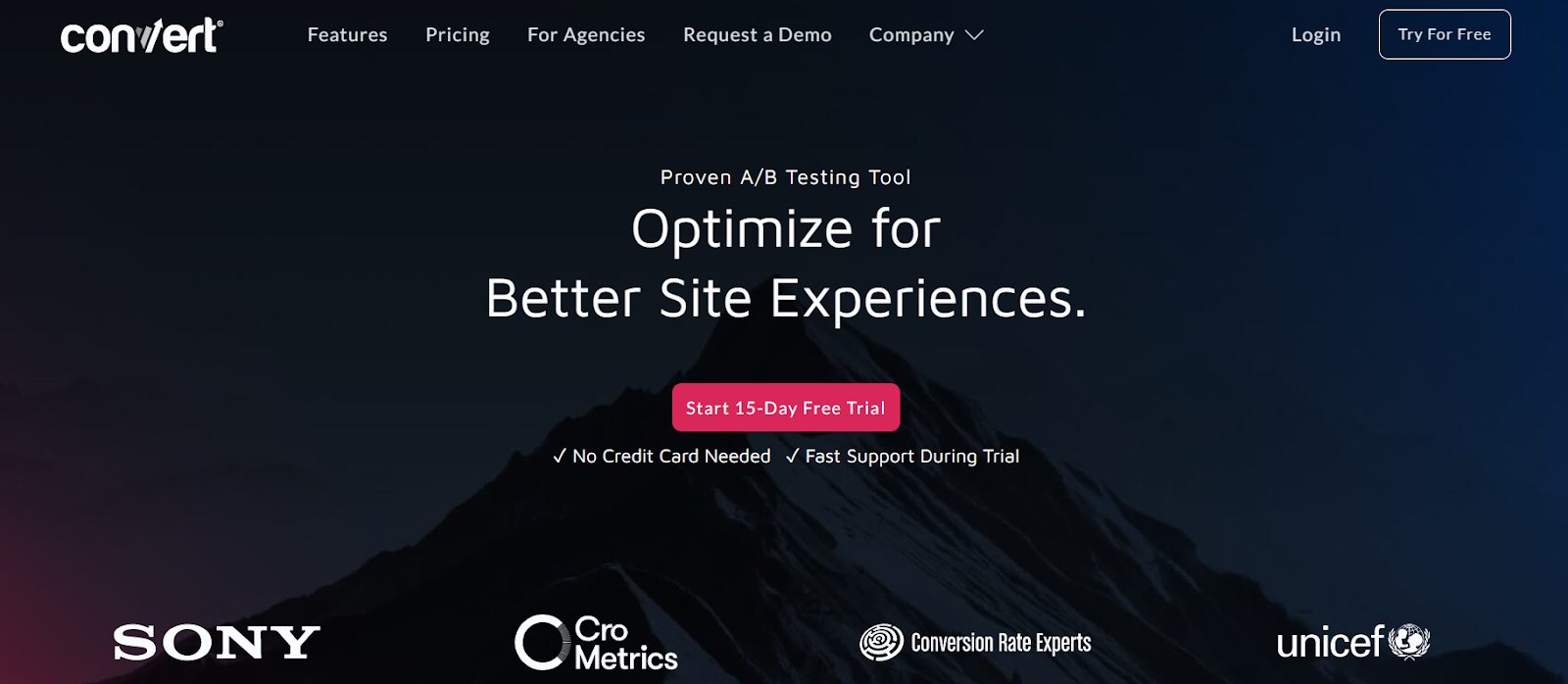
Convert is a well-established A/B testing platform. It has been serving businesses for over a decade. The platform caters to a wide range of market segments, from small businesses to large enterprises. It provides comprehensive solutions tailored to meet various organizational needs.
Test types: A/B Testing, Split URL Testing, Multivariate Testing
Statistical model: Convert allows users to choose between two statistical models for test analysis: Frequentist and Bayesian.
Noteworthy features: Audience targeting engine with over 40 filtering options, visual editor, post segmentation, and code editor.
AI-based features: The platform has AI-based text suggestions to improve content and create A/B test variations.
Supported testing platforms: Web, Server-side
Pricing:
The platform offers transparent pricing, with plans tailored based on the number of monthly tracked users. Both annual and monthly options are available. Below are the details of the annual plans:
- Entry: $199/month for up to 100K monthly tracked users
- Specialist: $999/month for up to 400K monthly tracked users
- Pro: $1,699/month for up to 700K monthly tracked users
- Enterprise: Custom price available upon request
| Pros | Cons |
| SmartInsert ensures flicker-free client-side testing, with variation switching in 200-300 ms on the first load and 10-50ms on repeat loads. | Necessary to implement multiple code snippets to achieve SPA compatibility, which makes testing dynamic websites a cumbersome process. |
A customer experience as per G2 reviews:
“Incredibly quick tool providing tons of performance and flicker less A/B testing, all packed in an intuitive UI.” – Aleksander Lach, Digital Product & CRO Manager at AIHR
8. Omniconvert
![]()
Omniconvert is a digital experience optimization platform designed to help direct-to-consumer (D2C) businesses globally enhance customer experiences across acquisition, optimization, and retention stages. It provides solutions such as web experimentation, personalization, customer analytics, and customer feedback tools.
Test types: A/B Testing, Split URL Testing
Statistical model: Omniconvert offers both statistical models: Frequentist and Bayesian.
Noteworthy features: WYSIWYG editor and audience segmentation.
AI-based features: The platform lacks AI-powered features specifically designed for A/B testing.
Supported testing platforms: Web
Pricing:
The pricing structure varies depending on the solution you choose, whether it’s A/B testing, analytics, or another feature, as well as the number of users you plan to test each month. The entry-level plan starts at $273 per month, accommodating up to 50,000 users.
| Pros | Cons |
| A powerful statistical engine allows the creation of relevant and tailored user experiences at an individual level. | Multi-armed bandit, multivariate testing, mutually exclusive campaigns, and server-side testing are missing. |
A customer experience as per G2 reviews:
“A highly intuitive and easy to use user interface (UI), providing your operation with critical marketing optimization tactics like RFM and NPS, which go hand in hand with more advanced techniques such as A/B Testing.” – Max E. Sequeira Garza, eCommerce expert
Wonder why we say Multi-armed Bandit testing is an advanced testing feature? To learn how it can contribute to your bottom line, watch this webinar.
9. LaunchDarkly
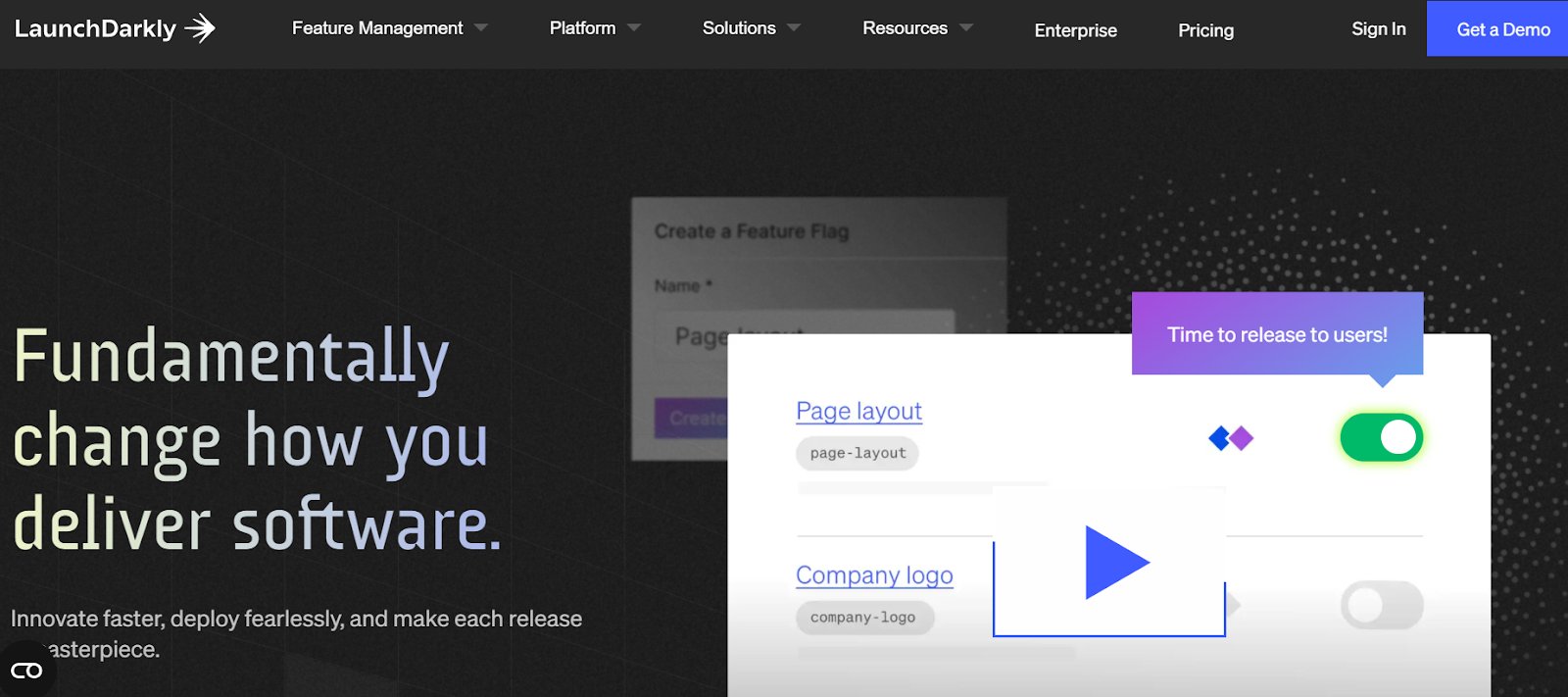
LaunchDarkly is a feature management platform designed for modern enterprises. It offers tools for web experimentation, feature testing, feature flagging, and experience personalization through a unified dashboard. The platform lets you have precise control over the customer experience, allowing you to conduct safe testing in production, obtain valuable feedback from users, and accelerate product release cycles. LaunchDarkly covers all major platforms like Xamarin, Swift, Java, .Net, C/C++, Salesforce, Python, and more with its SDKs.
Test types: A/B Testing, Split URL Testing, Multivariate Testing
Statistical model: LaunchDarkly uses Bayesian statistics in its experimentation.
Noteworthy features: Funnel experiments, and full-stack optimization.
AI-based features: The platform lacks AI-powered features specifically designed for A/B testing.
Supported testing platforms: Mobile app, Server-side
Pricing:
LaunchDarkly offers clear and transparent pricing across three plans:
- Developer – Free
- Foundation – $12/month
- Enterprise – Custom pricing
| Pros | Cons |
| Faster iterations are based on continuous user feedback to constantly improve the product. | No facility to conduct web testing using a drag-and-drop editor, which could reduce the involvement of IT and product teams. |
A customer experience as per G2 reviews:
“LaunchDarkly creates an event stream with the user’s browser, and the value of the feature flag gets updated on all the clients as soon as you update the value of the feature flag.” – Arvind Kalra, Senior Engineer at Postman
Curious to discover more about feature flags? How about watching a webinar to clear all your doubts?
10. Statsig
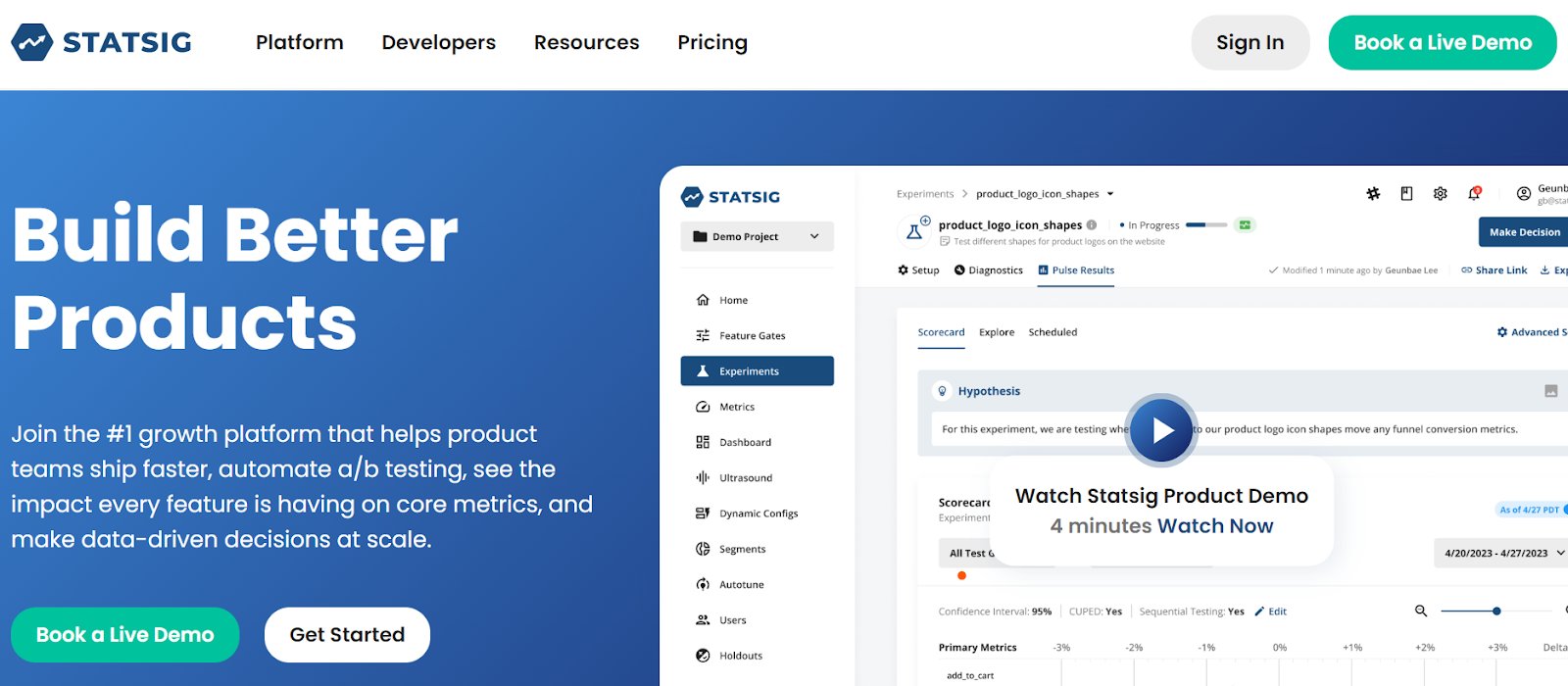
Statsig is a feature management and experimentation platform designed to help users seamlessly launch, test, and analyze new features.
Test types: A/B Testing, Split URL Testing, Multivariate Testing
Statistical model: Statsig uses Bayesian and Frequentist statistics in its experimentation model.
Noteworthy features: Visual editor, no-code web analytics, multi-armed bandit testing, heterogeneous effect detection, and native support.
AI-based features: The platform lacks AI-powered features specifically designed for A/B testing.
Supported testing platforms: Web, Mobile app, Server-side
Pricing:
Statsig offers clear and transparent pricing across three plans:
- Developer – Free
- Pro – Starting at $150/month
- Enterprise – Custom pricing
- Warehouse – Custom pricing
| Pros | Cons |
| Its stats engine processes raw events, exposure events, and pre-computed metrics to enrich your experimentation strategy. | Calls for technical expertise to perform complex experiments. |
A customer experience as per G2 reviews:
“Statsig is incredibly intuitive and easy to use. Setting up and running experiments is seamless, and the UI is extremely user-friendly.” – André Costa, Staff Data Scientist at Rei do Pitaco
11. Unbounce
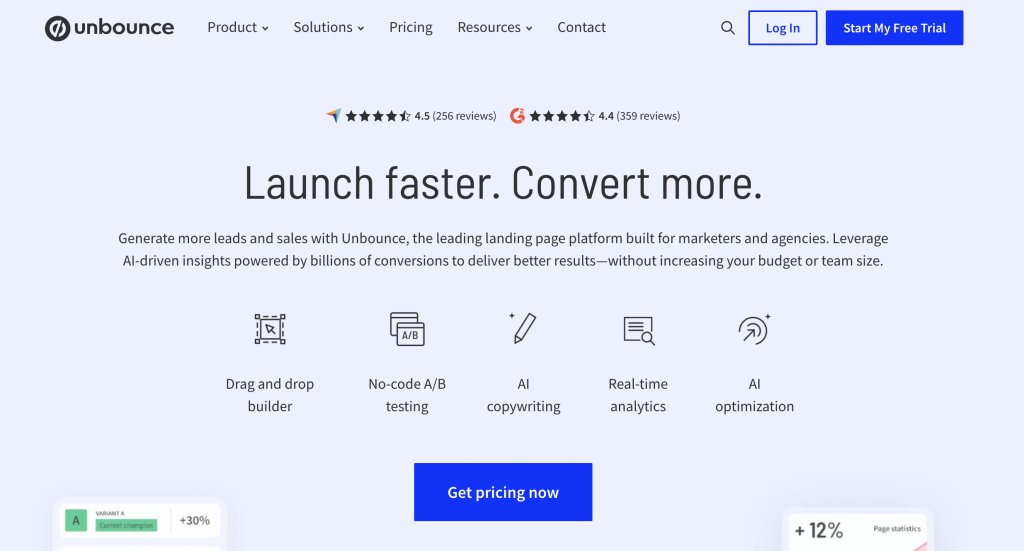
Unbounce is a landing page builder platform that also provides A/B testing, real-time analytics, and AI-driven tools for optimization and copywriting.
Test types: A/B Testing, Multivariate Testing
Statistical model: Unbounce provides limited details about its statistical models, so it’s unclear whether it uses a Bayesian or Frequentist approach for A/B testing analysis.
Noteworthy features: WYSIWYG editor, data integration with third-party platforms.
AI-based features: The platform has AI-based traffic allocation to win variation along with AI-based copywriting.
Supported testing platforms: Web
Pricing:
Unbounce offers clear and transparent pricing across four plans:
- Build – $74 /month (No A/B testing)
- Experiment – $112 /month
- Optimize – $187/month
- Concierge – $649/month
| Pros | Cons |
| It quickly allows users to create landing pages, as quickly as in a day. Also, the experimentation and reporting feature makes it easy for users to quickly start with A/B tests. | Limited design flexibility and occasional glitches are frustrating. |
A customer experience as per G2 reviews:
“Really easy WYSIWYG editor for landing pages, forms, etc. Also has integrations into things like Hubspot.” – Matthew Gardner, Co-Founder and CX at RouteThis
12. ABsmartly
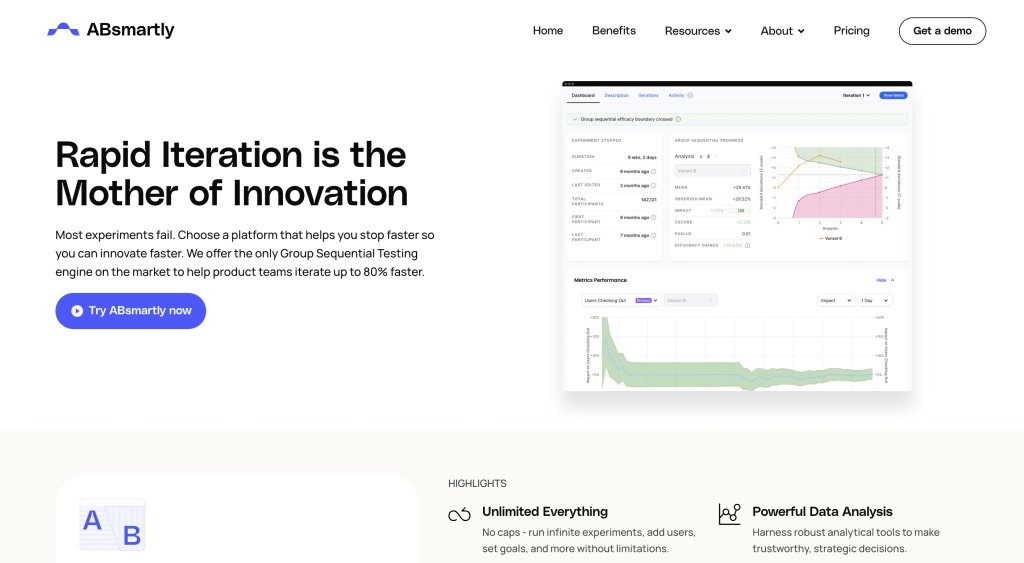
ABsmartly is an experimentation platform tailored for B2C companies. It supports cross-channel and cross-platform testing. The platform claims the ability to run experiments up to 80% faster than other tools on the market.
Test types: A/B Testing, Split URL Testing, Multivariate Testing
Statistical model: ABsmartly provides limited details about its statistical models, so it’s unclear whether it uses a Bayesian or Frequentist approach for A/B testing analysis.
Noteworthy features: Debugging & guardrails, experiment library, robot and scraper detection, conflicting experiments detection.
AI-based features: The platform doesn’t feature any AI-based features.
Supported testing platforms: Web, Email, Mobile app, Server-side
Pricing: ABsmartly uses event-based pricing, starting at €60K per year for up to 50 million events per month.
| Pros | Cons |
| It offers group sequential testing that makes A/B testing faster. | Lack of behavior insights and AI-based features. |
A customer experience as per G2 reviews:
“Translating advanced statistics into easy-to-read results. Plus, it has a very reliable engine, without any impact on your product performance.” – Karol Wojciechowski, Product Operations Manager, Serko Ltd.
13. SiteSpect
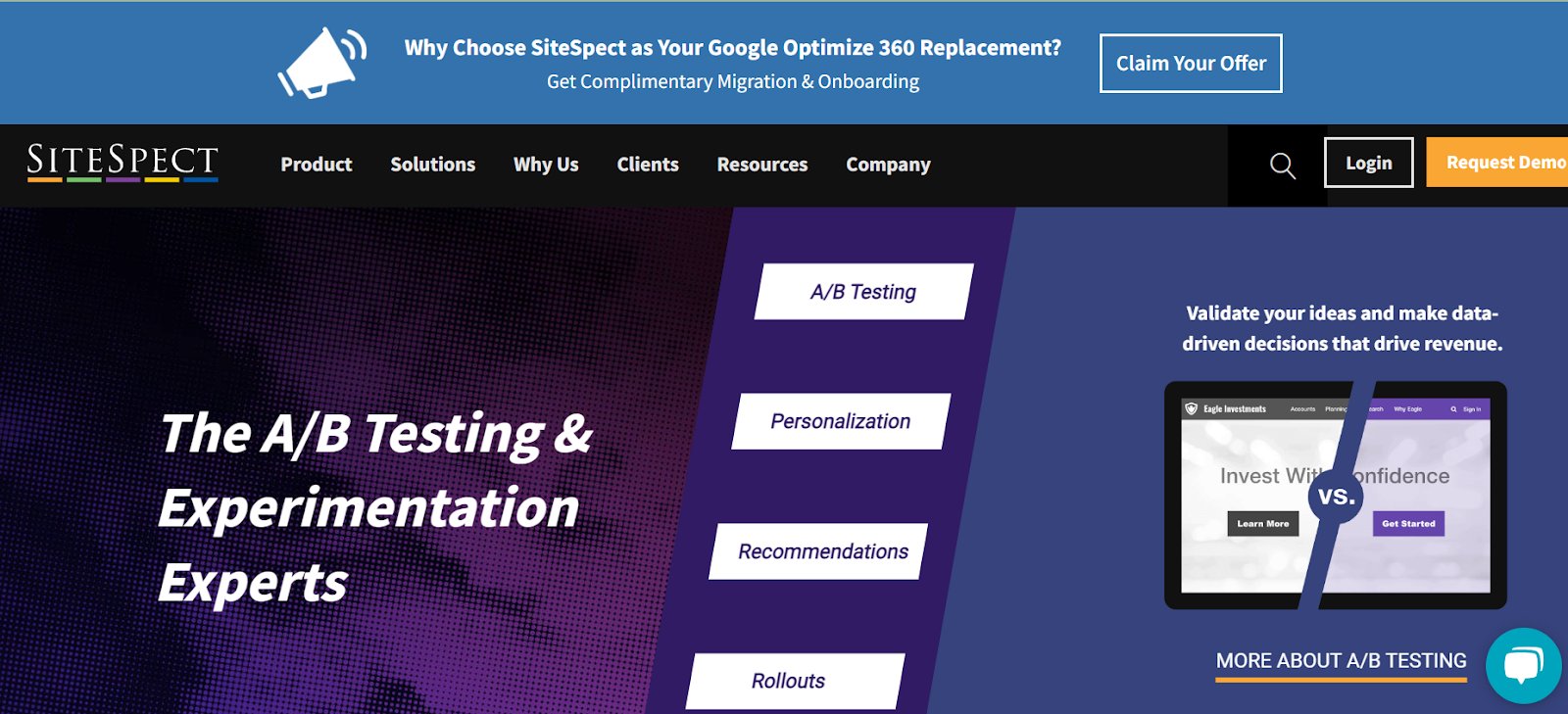
SiteSpect is an A/B testing and optimization platform offering a suite of solutions, including A/B testing, personalization, and product recommendations.
Test types: A/B Testing, Split URL Testing, Multivariate Testing
Statistical model: The stats engine uses the Frequentist statistics model.
Noteworthy features: Visual editor, auto-promotion of winning variations, mobile targeting capabilities with preferred markup languages HTML or WAP/WML, and comprehensive API
AI-based features: The platform doesn’t have any AI-based features.
Supported testing platforms: Web, Mobile app, Server-side
Pricing: It is available on request.
| Pros | Cons |
| No flickering effect and ensures high performance across all devices. | The absence of a CDP prevents the fullest utilization of customer data to improve optimization programs. |
A customer experience as per G2 reviews:
“Tool with a user-friendly UX and amazing technical support.” – Gregorio Pinto, Product Manager at Teleflora
14. Apptimize
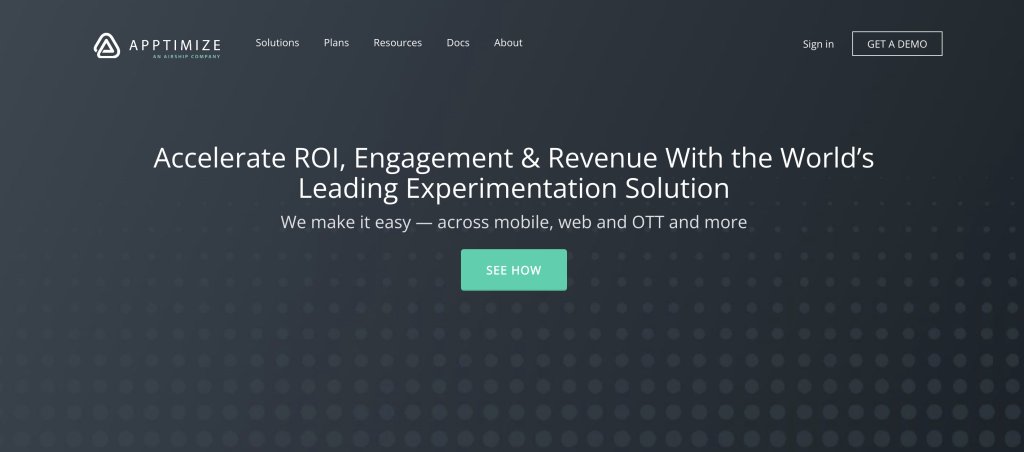
Apptimize is a versatile cross-channel A/B testing tool that enables experimentation across platforms. It allows users to create personalized experiences, manage feature releases across multiple channels, and oversee multi-channel experiments—all from a single, streamlined dashboard.
Test types: A/B Testing, Split URL Testing, Multivariate Testing
Statistical model: Apptimize provides limited details about its statistical analysis, so it’s unclear whether it uses a Bayesian or Frequentist approach for A/B testing analysis.
Noteworthy features: WYSIWYG editor, audience segmentation and targeting, patented technology for cross-platform testing.
AI-based features: The platform doesn’t have any AI-based features.
Supported testing platforms: Web, App, Server-side, OTT
Pricing: Apptimize offers a free plan, while its advanced and enterprise plans come with pricing available upon request.
| Pros | Cons |
| Cross-platform experimentation allows to track impact on all platforms if a change is made in one. | Dashboard can be overwhelming at the start which creates a steep learning curve. |
15. Split.io
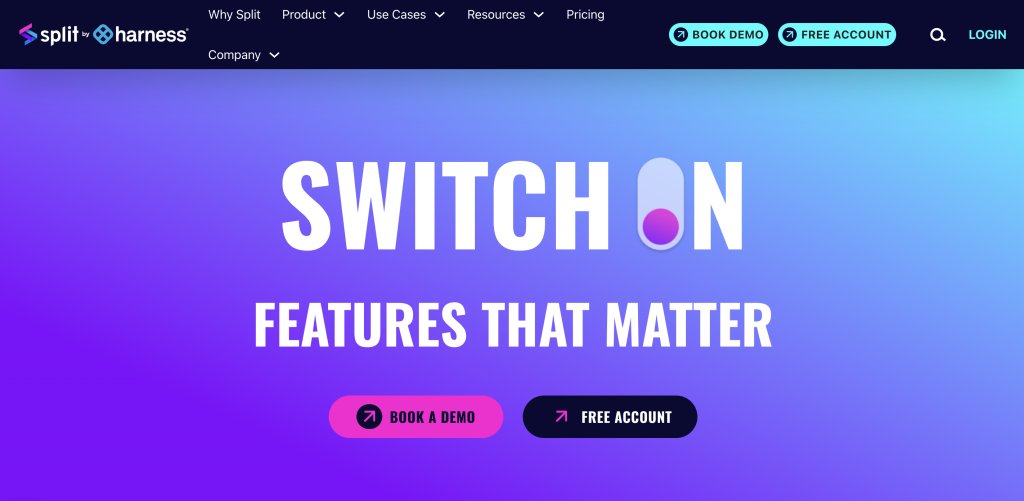
Split.io is a feature delivery platform designed to streamline feature flag management, software experimentation, and continuous delivery. It combines the speed and control of feature flags with data-driven insights to measure the impact of each feature. The platform supports languages like Java, JavaScript, .Net, Node.js, PHP, Python, Redux, React, Ruby, Ruby on Rails, iOS, and GoLang.
Test types: A/B Testing, Split URL Testing, Multivariate Testing
Statistical model: Split.io uses the Frequentist statistics model.
Noteworthy features: Guardrail metric, instant feature impact detection, and integration with all major platforms.
AI-based features: The platform didn’t have A/B testing specific AI-based features, but has a Chatbot called “Switch” for instant customer support.
Supported testing platforms: Web, Mobile app, Server-side
Pricing:
Split.io offers clear and transparent pricing across three plans:
- Starter – Free
- Startup – $35/month
- Enterprise – custom pricing
| Pros | Cons |
| SDK architecture allows user data to be processed locally to prevent sending private info to the cloud. | No separate packages for client and server-side SDKs. |
A customer experience as per G2 reviews:
“The best feature of Split.io is its ease of use and integration. We use it for controlling feature rollouts on many of our projects.” – Simon Orchanian, QA Manager at Agero
Now that we’ve explored leading A/B testing softwares in the market, let’s dive into important use cases and understand how to select a tool that solves challenges relevant to you.
Choosing the right A/B testing tool
We’ve shortlisted 15 A/B testing tools. Now, let’s refine our selection process by discussing the key criteria for shortlisting. We will identify which tools excel in each specific area to help you find the best fit for your needs.
An A/B testing tool should be easy to use and simple to onboard team members. Optimization—especially conversion rate optimization—is not a one-person job. It requires collaboration, ideally involving the entire marketing department. To drive real change, the tool should be accessible and have a low learning curve to ensure everyone can engage effectively and adopt the right mindset.
– David Otero,
Growth Specialist at DLTC
1. Are you seeking a one-stop solution for all your conversion rate optimization (CRO) needs?
Handling multiple tools can be a hassle. If you’re looking for a tool that caters to various facets of CRO like behavior analysis, personalization, and data management, then here are tools that we recommend.
| Tool name | VWO | Statsig | Omniconvert |
| Features | 1. Visitor behavior 2. Multichannel experimentation 3. Personalization 4. Customer data platform 5. Project management | 1. Multichannel experimentation 2. Product and customer behavior analytics 3. Web analytics | 1. Experimentation 2. Personalization 3. Surveys 4. E-commerce specific analysis and optimization tool |
2. Want to kickstart your journey with a free starter plan?
Investing in a CRO tool can be a huge commitment. If your business wants to take small steps in building a CRO culture by first investing in a tool that offers a free plan then here are the tools that we recommend:
| Tool name | VWO | LaunchDarkly | Statsig |
| Plan details | Forever free upto 50k monthly tracked users for web | Free plan with 10k experimentation keys per month | Free plan with 2M Events/month for analytics, and experiments. |
3. Looking for rapid experimentation with AI in A/B testing?
Artificial intelligence has quickly become an integral part of solutions across various industries, and the optimization and testing space is no exception. If you’re aiming to accelerate your testing process with AI-driven features, here are some tools that we think are best suited.
| Tool name | VWO | Adobe Target | Kameleoon |
| Feature details | Generative AI feature to generate personalized testing ideas for specific web pages and goals. | AI-based feature to automatically allocate more traffic to winning variation beforehand. | AI feature helps in generating A/B test variation, targeting audience segments, and analyzing A/B test results. |
I recently had a discussion with a CRO colleague about the need for a tool that uses AI to combine multiple data sources – such as analytics, heatmaps, session recording and heuristic analysis – to generate recommendations. I don’t think we are too far off from a tool like this, where much of the heavy lifting during the research phase is cut down, allowing the marketer to focus on strategy and implementation.
– Ilan Hurwitz,
Founder at Clever Conversions
Source: Insights from Ilan Hurwitz
4. Have questions on user privacy?
Privacy is becoming a top priority for most businesses today. If your goal is to run experiments while ensuring that visitor data remains secure, here are the tools that we think are the best.
| Tool name | VWO | LaunchDarkly | Optimizely |
| Compliance | GDPR CCPA PCI DSS HIPAA ISO 27001:2013 ISO 27001:2019 SOC 2 Type II | GDPR CCPA ISO 27001 ISO27701 HIPAA FedRAMP SOC 2 Type II | GDPR CCPA PCI DSS ISO 27001:2013 |
5. Want to explore tools backed by outstanding reviews and testimonials?
If your criteria for selecting an A/B testing tool focus on positive reviews, extensive market presence, and high user satisfaction from current clients, then the G2 Grid for A/B Testing is a must-see. It highlights the top tools based on these factors.
From our list of 15 shortlisted tools, VWO, AB Tasty, and LaunchDarkly stand out with impressive satisfaction ratings, making them strong contenders for your consideration.
6. Want to expedite your decision with an interactive feature comparison tool?
If you want to compare the top A/B testing software feature by feature, we’ve got you covered. Here’s a preview of the free interactive tool that helps you make a side-by-side comparison.
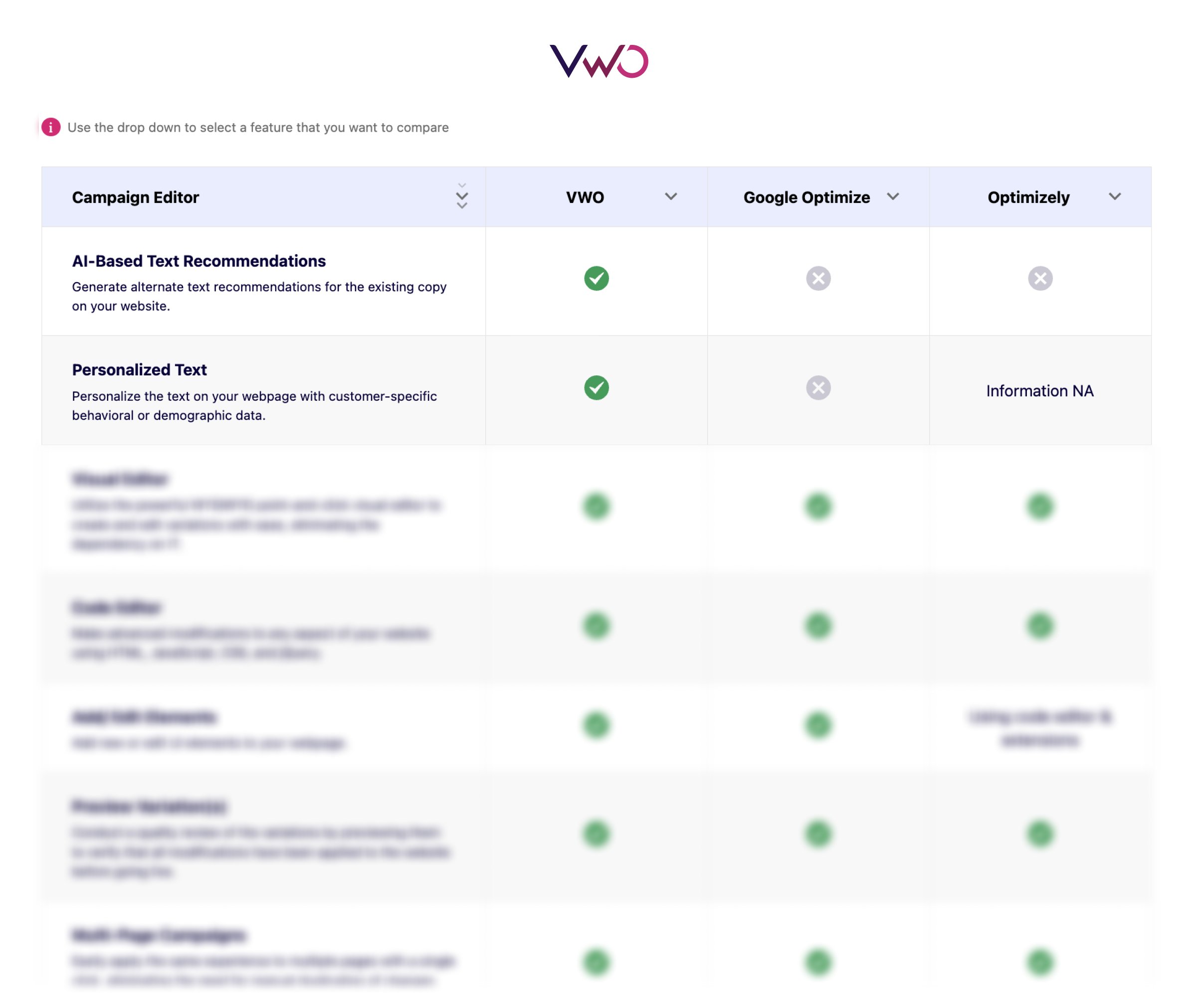
Choose your criteria and check which platform offers what you need. Explore the full A/B testing tools comparison here.
When selecting an A/B testing tool, prioritize those with advanced targeting capabilities and seamless integrations with third-party platforms. This ensures you can run precise, tailored experiments and effortlessly integrate test results into your broader marketing strategies for more effective decision-making and improved customer experiences.
Download Free: A/B Testing Guide
Wrapping up
Did you enjoy checking out our top picks for the best A/B testing tools? We get it, selecting amongst the best A/B testing platforms for your needs can be tricky because every tool has its strengths and weaknesses. Take your time and do a thorough comparison to make the best decision for your business.
Quick note: As you’re in the process of selecting an A/B testing tool, there is a report that can guide your entire A/B testing journey with insights specific to your industry. VWO analyzed over 1 million A/B tests run on 100,000 websites across 18 industries. The in-depth analysis has revealed industry-specific trends, such as average A/B test success rates, most common conversion goals, and more.
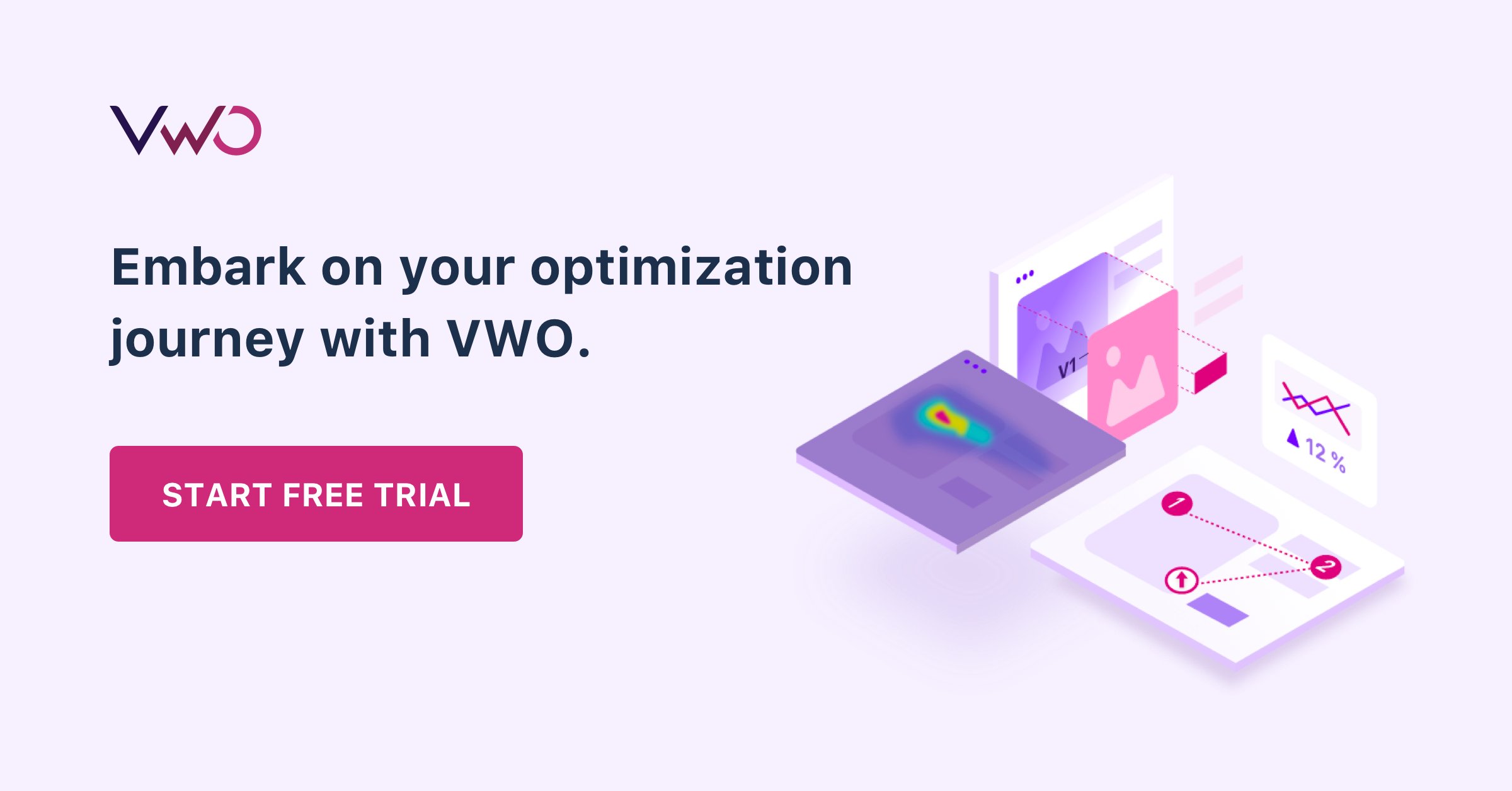
Frequently asked questions
To create a successful A/B testing framework or strategy, it is crucial to:
1. Define your goal – identify which metric you want to improve by implementing the test.
Make observations – understand your website friction and identify any issues by conducting quantitative and qualitative data research.
2. Formulate a hypothesis – Analyze user behavior to create a hypothesis.
Run tests – conduct A/B tests for a sufficient period to obtain statistical significance.
3. Calculate the A/B test duration here.
4. Interpret results – analyze the test results carefully to make data-driven decisions and implement the winning variation.
5. Conduct post-test analysis – analyze the results and identify areas and website elements like key CTAs for improvement in your test report.
With these steps, you can create a structured and effective A/B testing framework or strategy that leads to actionable insights and meaningful improvement in your website or app.
If your in-house team lacks the necessary expertise to spearhead an end-to-end app or website optimization program, you can hire professional people offering A/B testing services. At VWO, our success team can identify optimization opportunities, create tests, and analyze learnings to help build an experimentation culture in your organization. So, if you’re looking for an integrated experimentation platform and top-notch professional assistance, VWO should be your top choice.
Not all website testing tools offer mobile app testing capability. If you’re looking for mobile app testing tools, you can consider opting for VWO which makes mobile app testing a breeze. VWO offers lightweight SDKs for iOS, Android, and other widely used backend languages. Once you integrate the mobile app SDK, VWO will generate API keys that you can use for initializing your iOS and Android apps. For a detailed explanation of the steps involved, please refer to our guide.
A/B testing software allows you to test two different versions of a website element to see which one improves your business metric. You can set conversion goals, create multiple variations, split audiences, and even analyze your test results through data visualization charts on these testing tools. With some of the best split testing tools, you can even slice and dice test reports to evaluate how a test performed for a specific segment. To get more insights into each of these steps, you can read our comprehensive guide.
Before you choose an experimentation platform, it’s important to make careful considerations and be aware of limitations. For example, if your website doesn’t get enough traffic, it can be a tad difficult to get statistically significant results. In that case, you would want to explore ways to increase the flow of relevant website traffic first and then get a tool to run a test. Here’s a blog you may want to read to learn more about testing on low-traffic websites.
Also, avoid A/B testing if your hypothesis is not data-driven and is solely based on guesswork. To determine if a test can optimize user experience, it’s crucial to base your idea on user behavior across your website. VWO’s experimentation platform stands out from others by offering both behavior analysis and testing capabilities, ensuring that your tests are based on solid hypotheses derived from user insights.
When running an A/B test on any testing tools, choose a metric that aligns with the business goals. For instance,
If you run an eCommerce business, you’d focus on KPIs like average order value, revenue per visitor, or conversion metrics like page visits or email subscriptions.
On the other hand, if yours is a SaaS website and you want to run a test on it, you’d want to set metrics like free trial conversions, form submissions, subscriptions, customer lifetime value, and so on.
You should also consider bounce rates, regardless of your business model, to assess user engagement and determine if visitors are leaving your website prematurely without converting.


 –
– 



